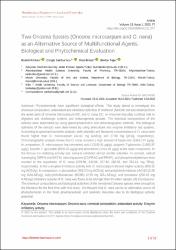| dc.contributor.author | Kırkan, Bülent | |
| dc.contributor.author | Sarıkürkçü, Cengiz | |
| dc.contributor.author | Binzet, Rıza | |
| dc.contributor.author | Tepe, Bektaş | |
| dc.date.accessioned | 2022-06-09T09:46:22Z | |
| dc.date.available | 2022-06-09T09:46:22Z | |
| dc.date.issued | 06.02.2022 | en_US |
| dc.identifier.issn | 2069-5837 | |
| dc.identifier.uri | https://doi.org/10.33263/BRIAC131.077 | |
| dc.identifier.uri | https://hdl.handle.net/20.500.12933/1142 | |
| dc.description.abstract | Phytochemicals have significant biological effects. This study aimed to investigate the chemical composition, antioxidant and inhibitory activities of methanol (MeOH) extracts obtained from the aerial parts of Onosma microcarpum DC. and O. nana DC. on enzymes that play a critical role in digestive and cholinergic systems and melanogenesis process. The chemical compositions of the extracts were determined by using spectrophotometric and chromatographic methods. The biological activities of the extracts were determined by using antioxidant and enzyme inhibitory test systems. According to spectrophotometric analysis, both phenolic and flavonoid concentrations of O. nana were found higher than O. microcarpum (44.63 mg GAEs/g and 27.86 mg QEs/g, respectively). Chromatographic analysis shows that O. nana contains a high amount of hesperidin (53412.37 µg/g). In comparison, O. microcarpum has rosmarinic acid (13181.91 µg/g), apigenin 7-glucoside (11693.97 µg/g), luteolin 7-glucoside (8632.03 µg/g) and pinoresinol (1014.26 µg/g) as the main compounds. In the ferrous ion chelating activity test, extracts exhibited almost similar activities. In contrast, radical scavenging (DPPH and ABTS), reducing power (CUPRAC and FRAP), and phosphomolybdenum tests resulted in the superiority of O. nana (229.98, 243.58, 327.46, 189.69, and 783.14, mg TEs/g, respectively). In the α-amylase inhibitory activity test, O. microcarpum showed higher activity (406.31 mg ACEs/g). In comparison, α-glucosidase (958.23 mg ACEs/g) and acetylcholinesterase (AChE) (2.80 mg GALAEs/g), butyrylcholinesterase (BChE) (2.59 mg GALAEs/g), and tyrosinase (200.43 mg KAEs/g) inhibitory activity of O. nana was found to be stronger than the other sample. (4) Conclusions: The chemical compositions and biological activities of the mentioned Onosma species were brought to the literature for the first time with this study. It is thought that O. nana can be an alternative source of phytochemicals in the food, pharmaceutical, and cosmetic industries due to its biological activity potential. | en_US |
| dc.language.iso | eng | en_US |
| dc.publisher | AMG Transcend Association | en_US |
| dc.relation.isversionof | 10.33263/BRIAC131.077 | en_US |
| dc.rights | info:eu-repo/semantics/openAccess | en_US |
| dc.subject | Onosma microcarpum | en_US |
| dc.subject | Onosma nana | en_US |
| dc.subject | Chemical composition | en_US |
| dc.subject | Antioxidant activity | en_US |
| dc.subject | Enzyme inhibitory activity | en_US |
| dc.title | Two Onosma Species (Onosma microcarpum and O. nana) as an Alternative Source of Multifunctional Agents: Biological and Phytochemical Evaluation | en_US |
| dc.type | article | en_US |
| dc.authorid | 0000-0001-5094-2520 | en_US |
| dc.department | AFSÜ, Eczacılık Fakültesi, Temel Eczacılık Bilimleri Bölümü | en_US |
| dc.contributor.institutionauthor | Sarıkürkçü, Cengiz | |
| dc.identifier.volume | 13 | en_US |
| dc.identifier.issue | 1 | en_US |
| dc.identifier.startpage | 1 | en_US |
| dc.identifier.endpage | 13 | en_US |
| dc.relation.journal | Biointerface Research in Applied Chemistry | en_US |
| dc.relation.publicationcategory | Makale - Uluslararası Hakemli Dergi - Kurum Öğretim Elemanı | en_US |
















